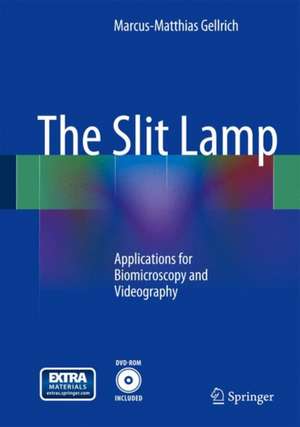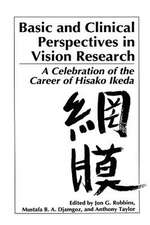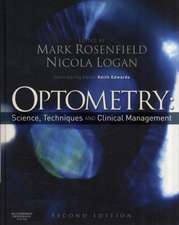The Slit Lamp: Applications for Biomicroscopy and Videography
Autor Marcus-Matthias Gellrichen Limba Engleză Mixed media product – 11 dec 2013
| Toate formatele și edițiile | Preț | Express |
|---|---|---|
| Paperback (1) | 647.47 lei 38-44 zile | |
| Springer Berlin, Heidelberg – 4 mai 2017 | 647.47 lei 38-44 zile | |
| Mixed media product (1) | 727.97 lei 3-5 săpt. | |
| Springer Berlin, Heidelberg – 11 dec 2013 | 727.97 lei 3-5 săpt. |
Preț: 727.97 lei
Preț vechi: 766.28 lei
-5% Nou
Puncte Express: 1092
Preț estimativ în valută:
139.31€ • 151.27$ • 117.02£
139.31€ • 151.27$ • 117.02£
Carte disponibilă
Livrare economică 01-15 aprilie
Preluare comenzi: 021 569.72.76
Specificații
ISBN-13: 9783642397929
ISBN-10: 3642397921
Pagini: 200
Ilustrații: XVII, 218 p. 252 illus., 229 illus. in color. With DVD.
Dimensiuni: 178 x 254 x 20 mm
Greutate: 0.72 kg
Ediția:2014
Editura: Springer Berlin, Heidelberg
Colecția Springer
Locul publicării:Berlin, Heidelberg, Germany
ISBN-10: 3642397921
Pagini: 200
Ilustrații: XVII, 218 p. 252 illus., 229 illus. in color. With DVD.
Dimensiuni: 178 x 254 x 20 mm
Greutate: 0.72 kg
Ediția:2014
Editura: Springer Berlin, Heidelberg
Colecția Springer
Locul publicării:Berlin, Heidelberg, Germany
Public țintă
Professional/practitionerCuprins
Basics: Appliance Construction. Biomicroscopy: Types of Illumination.- Biomicroscopy without Additional Lenses.- Biomicroscopy with Additional Lenses.- Accessory Equipment for Slit Lamps. Videography with the Slit Lamp: Videography - the Basics.- Special Videography Applications.- Specific Videographic Settings for Specific Ocular Diseases. History of the Slit Lamp: History of Slit Lamp Construction.- Bibliography.
Notă biografică
Dr. Marcus-Matthias Gellrich was born in 1962 in Lippstadt, Germany. He studied medicine in Kiel (1982-1989) and in Manchester, England. His thesis at the Neuroanatomical Institute in Kiel was on the “Morphometric evaluation of the retinal ganglion-cell layer after transection of the optic nerve”. From 1991 to 1996 Dr. Gellrich earned his certification in ophthalmology at the University Eye Hospital in Freiburg. Since 1996 he has been a certified practicing ophthalmologist in Kellinghusen, northern Germany. Dr. Gellrich has been devoting intensive scientific effort to the slit lamp since 2006. He is particularly enthusiastic about holding lectures and showing films, which he has done in English, French, and Russian in London, Birmingham, Paris, Odessa, Minsk, and Moscow. It is his most fervent desire to encourage and witness the modernization of the slit lamp so that its potential can be fully exploited in today’s ophthalmology practices. To that end, he believes that a “sea change” must take place, namely, from traditional biomicroscopy to a videographic approach that enables the slit lamp user to profit fully from recent technological breakthroughs such as videotechnology, digital image processing, and telemedicine. The German Society of Ophthalmology (Deutsche Ophthalmologische Gesellschaft) awarded Dr. Gellrich the 1st Videoprize in 2007 and the Special Videoprize in 2011. He was also the first practicing ophthalmologist to win the Hans Sautter Scientific Prize from the Association of North German Ophthalmologists.
Textul de pe ultima copertă
In this book the author describes in detail the history, construction, and examination potential of the slit lamp. In particular, however, he presents a new approach – videography – that allows the ophthalmologist to document all (!) eye diseases with the slit lamp and a video camera in a practicable, rapid, and affordable manner. The necessary methods, techniques, and equipment, including converging, diverging, and contact lenses, are clearly explained in the text and four didactic videos. The 20 most important videographic settings are described, and “recipes” for their use are presented, along with diagnostic tips. The accompanying collection of clinical images represents the world’s first ever general atlas of ophthalmology from the perspective of the slit lamp.
The author has already demonstrated proof of the value of ophthalmological videography in his own practice. It is his hope that this introductory book, with its many images never previously produced with a slit lamp, will stimulate others to exploit the approach’s potential.
The author has already demonstrated proof of the value of ophthalmological videography in his own practice. It is his hope that this introductory book, with its many images never previously produced with a slit lamp, will stimulate others to exploit the approach’s potential.
Caracteristici
Presents the new approach of videography, which allows documentation of all eye diseases with the slit lamp Fully describes the techniques, methods, and equipment Documents the 20 most important videographic settings Includes an impressive collection of clinical images?




















